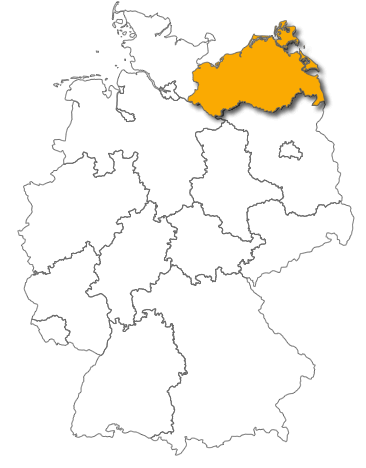Mecklenburg-Vorpommern is located in the northeastern corner of Germany on the Baltic Sea coast and shares a border with Poland to the east.
The state neighbors Brandenburg to the south, Lower Saxony to the southwest, and Schleswig-Holstein to the west. Berlin lies about 210 kilometres south of the state capital, Schwerin.
The region consists of two historical territories: Mecklenburg in the west and Vorpommern (Western Pomerania) in the east.
Rostock serves as the state's largest city and main port. Its population of just over 200,000 makes it four times larger than Schwerin.
The island of Rügen, Germany's largest island, draws many visitors to its chalk cliffs and beach resorts. The Hanseatic city of Stralsund acts as a gateway to Rügen and features its own well-preserved medieval centre.

The closest major international airports to Mecklenburg-Vorpommern are actually outside the state.
Berlin Brandenburg Airport (BER) offers the best international connections, with flights from most major European cities and some intercontinental routes. The train journey from BER to Schwerin takes about three hours
Website: ber.berlin-airport.de
Hamburg Airport (HAM) is another good option, especially for visitors heading to the western part of the state. From Hamburg, travellers can reach Schwerin in less than two hours by train.
Website: www.hamburg-airport.de
Within Mecklenburg-Vorpommern itself, Rostock-Laage Airport serves mainly domestic flights and seasonal tourist routes. The airport serves a limited number of international destinations, mainly during the summer months with flights to popular holiday destinations.
Website: rostock-airport.de
The location of the state means that travellers often need to combine air travel with train or car travel. The Deutsche Bahn rail network has good connections to both Berlin and Hamburg airports, making transfers straightforward.
Most international visitors will find it best to fly into Berlin Brandenburg Airport, which has a wide range of international flights and good train connections.
Mecklenburg-Vorpommern has a well-connected rail network centred on two main routes. The main east-west line runs from Hamburg via Schwerin and Rostock to Stralsund. The north-south line connects Berlin with Rostock and its ferry port of Warnemünde.
InterCity (IC) and InterCity Express (ICE) trains serve the major cities. These fast trains run every two hours between Berlin and Rostock, with some continuing on to Stralsund. The journey from Berlin to Rostock takes about two hours.
Regional trains (RE and RB) connect smaller towns and tourist areas. These include routes to popular destinations like the island of Rügen and the Baltic Sea resorts. The Usedom island railway offers direct connections from Berlin to beach towns like Heringsdorf.
During summer, additional services run to handle increased tourist traffic. The "Hanse-Express" provides direct connections between Hamburg and the coastal resorts.
The state's main rail hubs are:
Most coastal towns have regular train service, though some smaller destinations may require a bus connection for the final stretch.
One of the best rail bargains in any state is the day pass for the (slower) regional services. In Mecklenburg-Vorpommern's case this is called the Mecklenburg-Vorpommern-Ticket and offers unlimited travel on local services from 09.00 to 03.00 the following day (or from midnight on weekends).
The single price is low (24 Euros Monday-Thursday at the time of writing and 25 Euros for Friday-Sunday) but the real bargain is that extra people can be added to the ticket up to a maximum of five for a relatively low cost. Thus five people can have unlimited regional rail travel for a day in Mecklenburg-Vorpommern for only 41 (or 46) Euros. (Note that Intercity services are not included.)
Website: www.bahn.de
The state's main motorway (Autobahn) network consists of four major routes:
A20 (Baltic Sea Motorway): Runs east-west across the entire state from Lübeck through Wismar, Rostock, and Greifswald to the Polish border. This is the state's most important highway for coastal access.
A19: Connects Berlin to Rostock, providing a direct route from the capital to the Baltic Sea. The highway meets the A20 near Rostock.
A14: Links Schwerin to Wismar in the west. Currently being extended south to Magdeburg, making access from western Germany easier.
A24: Though mainly running through Brandenburg, this important route connects Hamburg to Berlin via the southwestern corner of Mecklenburg-Vorpommern.
Most tourist destinations are accessible from these main routes via well-maintained federal highways (Bundesstraßen). The B96 is particularly important as it continues from the A20 to Rügen island, while the B105 connects coastal towns along the Baltic Sea.
These motorways are generally less congested than in other parts of Germany, except during peak holiday periods when coastal routes can become busy.
The German automobile club is called ADAC and it offers information on traffic and road conditions on its website (German only):
Website: www.adac.de